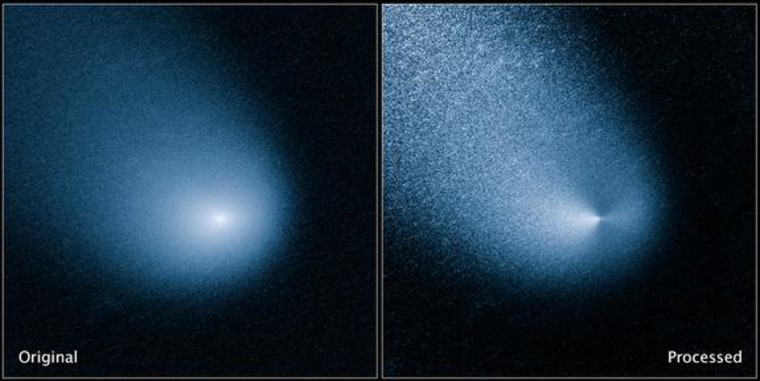A comet poised to give Mars a close shave later this year is now blasting dust into space from at least two jets on its surface, photos from the Hubble Space Telescope reveal.
The latest Hubble photo of Comet Siding Spring, captured on March 11, shows what appear to be two jets of dust coming off the icy object's nucleus. The comet is making its way toward the inner solar system for an Oct. 19 rendezvous with Mars, during which it will miss the planet by just 84,000 miles (135,185 kilometers) — about one-third the distance between Earth and the moon.

The new Hubble observations, along with other recent images of Comet Siding Spring taken by the space telescope on Jan. 21 and Oct. 29, are helping scientists learn key details about the comet, such as the axis of rotation of its nucleus and the speed at which Siding Spring is ejecting dust. NASA released the new Hubble comet photos on Thursday.
"This is critical information that we need to determine whether, and to what degree, dust grains in the coma of the comet will impact Mars and spacecraft in the vicinity of Mars," Jian-Yang Li, of the Planetary Science Institute in Tucson, Ariz., said in a statement.
Scientists still aren't sure how much of a threat Comet Siding Spring will pose to orbiters such as NASA's Mars Reconnaissance Orbiter and Mars Odyssey. They should start to get a better idea in April and May, as the comet gets closer to the sun and begins shedding more material.
- Mike Wall, Space.com
This is a condensed version of story that appeared on Space.com Read the entire article here. Follow Mike Wall on Twitter @michaeldwall and Google+. Follow us @Spacedotcom, Facebook or Google+.
- Collision Course? A Comet Heads for Mars
- Comet Quiz: Test Your Cosmic Knowledge
- The Night Sky in 2014: 11 Must-See Celestial Events (Infographic)
Copyright 2014 SPACE.com, a TechMediaNetwork company. All rights reserved. This material may not be published, broadcast, rewritten or redistributed.